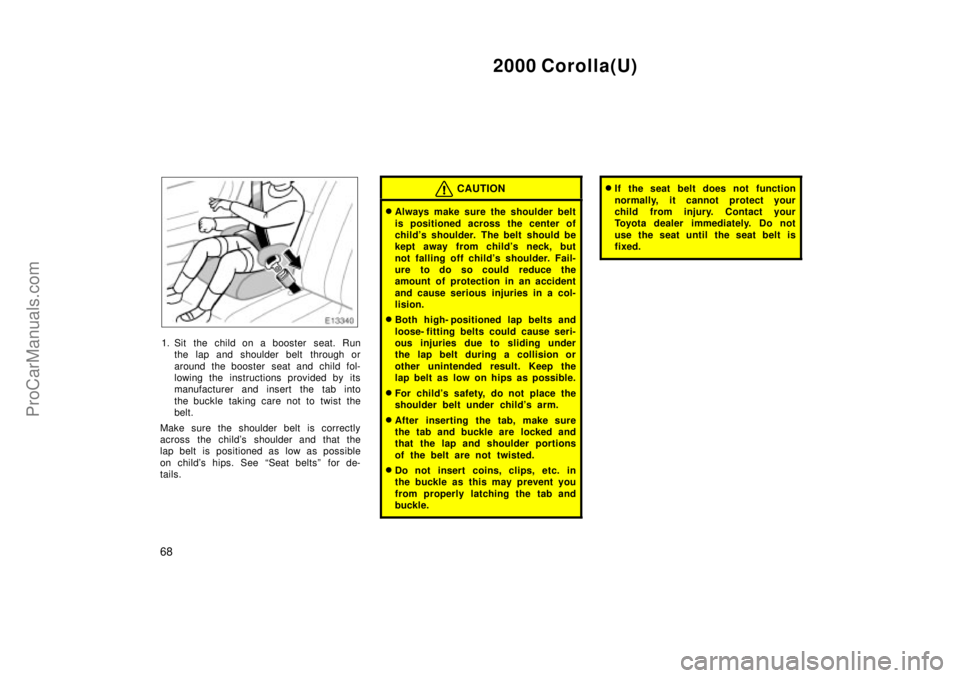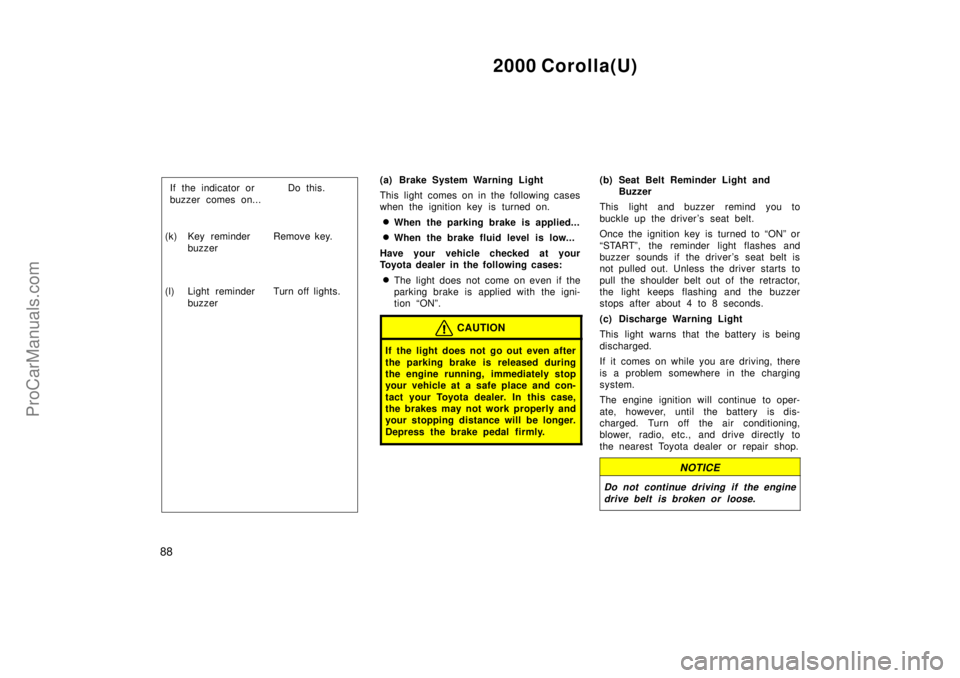Page 140 of 246
2000 Corolla(U)
66
3. While pressing the convertible seat
firmly against the seat cushion and
seatback, let the shoulder belt retract
as far as it will go to hold the convert-
ible seat securely.CAUTION
Push and pull the child restraint sys-
tem in different directions to be sure
it is secure. Follow all the installation
instructions provided by its manufac-
turer.
4. To remove the convertible seat, press
the buckle- release button and allow the
belt to retract completely. The belt will
move freely again and be ready to
work for an adult or older child passen-
ger.
ProCarManuals.com
Page 142 of 246

2000 Corolla(U)
68
1. Sit the child on a booster seat. Run
the lap and shoulder belt through or
around the booster seat and child fol-
lowing the instructions provided by its
manufacturer and insert the tab into
the buckle taking care not to twist the
belt.
Make sure the shoulder belt is correctly
across the child's shoulder and that the
lap belt is positioned as low as possible
on child's hips. See Seat beltsº for de-
tails.
CAUTION
�Always make sure the shoulder belt
is positioned across the center of
child's shoulder. The belt should be
kept away from child's neck, but
not falling off child's shoulder. Fail-
ure to do so could reduce the
amount of protection in an accident
and cause serious injuries in a col-
lision.
�Both high- positioned lap belts and
loose- fitting belts could cause seri-
ous injuries due to sliding under
the lap belt during a collision or
other unintended result. Keep the
lap belt as low on hips as possible.
�For child's safety, do not place the
shoulder belt under child's arm.
�After inserting the tab, make sure
the tab and buckle are locked and
that the lap and shoulder portions
of the belt are not twisted.
�Do not insert coins, clips, etc. in
the buckle as this may prevent you
from properly latching the tab and
buckle.
�If the seat belt does not function
normally, it cannot protect your
child from injury. Contact your
Toyota dealer immediately. Do not
use the seat until the seat belt is
fixed.
ProCarManuals.com
Page 143 of 246
2000 Corolla(U)
69
2. To remove the child restraint system,
press the buckle- release button and al-
low the belt to retract.
Ð U sin g a to p st rap
Follow the procedure below for a child
restraint system that requires the use
of a top strap.
Anchor brackets
Use the anchor bracket on the package
tray behind the rear seat to attach the top
strap.
ProCarManuals.com
Page 144 of 246
2000 Corolla(U)
70
TO USE THE ANCHOR BRACKET:
1. Outside anchor brackets onlyÐ
Remove the head restraint.2. Fix the child restraint system with
the seat belt.
Latch the hook onto the anchor
bracket and tighten the top strap.
For instructions to install the child re-
straint system, see ºChild restraintº in this
section.
CAUTION
Make sure the top strap is securely
latched, and check that the child re-
straint system is secure by pushing
and pulling it in different directions.
3. Outside anchor brackets onlyÐ
Replace the head restraint.
ProCarManuals.com
Page 161 of 246
2000 Corolla(U)
87
The thermometer indicates the outside
air temperature.
The key must be in the ONº position.
If there is some abnormality in the con-
nection of the outside air temperature sen-
sor, - Eº or Eº will appear on the display.
If - Eº or Eº appears on the display,
contact your Toyota dealer.(a) If parking brake
is off, stop
immediately and
contact Toyota
dealer.
(b) Fasten seat belt.If the indicator or
buzzer comes on...
(c) Stop and check.
(d) Take vehicle to
Toyota dealer.
(e) Fill up tank.(type A)
(type B)
(indicator and buzzer)Do this.
(f) Stop and check.
(g) Take vehicle to
Toyota dealer.
(h) Close all doors.
(i) Take vehicle to
Toyota dealer
immediately. (type A)
(type B)
(j) Add washer
fluid.If the indicator or
buzzer comes on...Do this.
Service reminder indicators
an d warn in g bu zzers
ProCarManuals.com
Page 162 of 246

2000 Corolla(U)
88
(k) Remove key.Key reminder
buzzer
(l) Turn off lights.Light reminder
buzzer If the indicator or
buzzer comes on...Do this.(a) Brake System Warning Light
This light comes on in the following cases
when the ignition key is turned on.
�When the parking brake is applied...
�When the brake fluid level is low...
Have your vehicle checked at your
Toyota dealer in the following cases:
�The light does not come on even if the
parking brake is applied with the igni-
tion ONº.
CAUTION
If the light does not go out even after
the parking brake is released during
the engine running, immediately stop
your vehicle at a safe place and con-
tact your Toyota dealer. In this case,
the brakes may not work properly and
your stopping distance will be longer.
Depress the brake pedal firmly.
(b) Seat Belt Reminder Light and
Buzzer
This light and buzzer remind you to
buckle up the driver's seat belt.
Once the ignition key is turned to ONº or
STARTº, the reminder light flashes and
buzzer sounds if the driver 's seat belt is
not pulled out. Unless the driver starts to
pull the shoulder belt out of the retractor,
the light keeps flashing and the buzzer
stops after about 4 to 8 seconds.
(c) Discharge Warning Light
This light warns that the battery is being
discharged.
If it comes on while you are driving, there
is a problem somewhere in the charging
system.
The engine ignition will continue to oper-
ate, however, until the battery is dis-
charged. Turn off the air conditioning,
blower, radio, etc., and drive directly to
the nearest Toyota dealer or repair shop.
NOTICE
Do not continue driving if the engine
drive belt is broken or loose.
ProCarManuals.com
Page 164 of 246

2000 Corolla(U)
90
If the light lit during driving goes out and
does not come on again, it is a normal
operation.
(h) Open Door Warning Light
This light remains on until all the doors
are completely closed.
(i) SRS Warning Light
This light will come on when the igni-
tion key is turned to the ACCº or
ONº position. After about 6 seconds,
the light will go off. This means the
system of the airbag and front seat belt
pretensioners are operating properly.
The warning light system monitors the air-
bag sensor assemblies, front airbag sen-
sors, seat belt pretensioner assemblies,
inflators, warning light, interconnecting wir-
ing and power sources.
If either of the following conditions occurs,
this indicates a malfunction somewhere in
the parts monitored by the warning light
system. Contact your Toyota dealer as
soon as possible to service the vehicle.
�The light does not come on when the
ignition key is turned to the ACCº or
ONº position or remains on.
�The light comes on or flashes while
driving.(j) Low Windshield Washer Fluid Level
Warning Light
The light warns that the windshield washer
fluid level is too low. Add washer fluid at
your earliest opportunity. (For instructions,
see Adding washer fluidº in Section 7- 3.)
(k) Key Reminder Buzzer
This buzzer reminds you to remove the
key when you open the driver 's door with
the ignition key in the ACCº or LOCKº
position.
(l) Light Reminder Buzzer
This buzzer will sound if the head light
switch is left on and the driver's door is
opened with the key removed from the
ignition switch.CHECKING SERVICE REMINDER INDICA-
TORS (except the low fuel level warning
light and low windshield washer fluid
level warning light)
1. Apply the parking brake.
2. Open one of the doors.
The open door warning light should
come on.
3. Close the door.
The open door warning light should go
off.
4. Turn the ignition key to ACCº.
The SRS warning light should come on.
It goes off after about 6 seconds.
5. Turn the ignition key to ONº, but do
not start the engine.
All the service reminder indicators ex-
cept the open door warning light and
SRS warning light should come on. The
ABSº warning light goes off after a
few seconds.
If any service reminder indicator or warn-
ing buzzer does not function as described
above, either the bulb is burned out or the
circuit is in need of repair. Have it
checked by your Toyota dealer as soon as
possible.
ProCarManuals.com
Page 220 of 246

2000 Corolla(U)
202
If you perform maintenance by yourself,
be sure to follow the correct procedure
given in this section.
You should be aware that improper or in-
complete servicing may result in operating
problems.
Performing do- it- yourself maintenance
during the warranty period may affect your
warranty coverage. Read the separate
Toyota Warranty statement for details and
suggestions.
This section gives instructions only for
those items that are relatively easy for an
owner to perform. As explained in Section
6, there are still a number of items that
must be done by a qualified technician
with special tools.
For information on tools and parts for do-
it- yourself maintenance, see Parts and
toolsº.
Utmost care should be taken when work-
ing on your vehicle to prevent accidental
injury. Here are a few precautions that
you should be especially careful to ob-
serve:CAUTION
�When the engine is running, keep
hands, clothing, and tools away
from the moving fan and engine
drive belts. (Removing rings,
watches, and ties is advisable.)
�Right after driving, the engine
compartmentÐthe engine, radiator,
exhaust manifold and spark plug
boots, etc.Ðwill be hot. So be care-
ful not to touch them. Oil, fluids
and spark plugs may also be hot.
�If the engine is hot, do not remove
the radiator cap or loosen the drain
plugs to prevent burning yourself.
�Do not smoke, cause sparks or al-
low open flames around fuel or the
battery. Their fumes are flammable.
�Be extremely cautious when work-
ing on the battery. It contains poi-
sonous and corrosive sulfuric acid.
�Do not get under your vehicle with
just the body jack supporting it. Al-
ways use automotive jack stands or
other solid supports.
�Be sure that the ignition is off if
you work near the electric cooling
fans or radiator grille. With the
ignition on, the electric cooling fans
will automatically start to run if the
engine coolant temperature is high
and/or the air conditioning is on.
�Use eye protection whenever you
work on or under your vehicle
where you may be exposed to flying
or falling material, fluid spray, etc.
�Used engine oil contains potentially
harmful contaminants which may
cause skin disorders such as in-
flammation or skin cancer, so care
should be taken to avoid prolonged
and repeated contact with it. To re-
move used engine oil from your
skin, wash thoroughly with soap
and water.
�Do not leave used oil within the
reach of children.
Do- it- yourself service
precautions
ProCarManuals.com